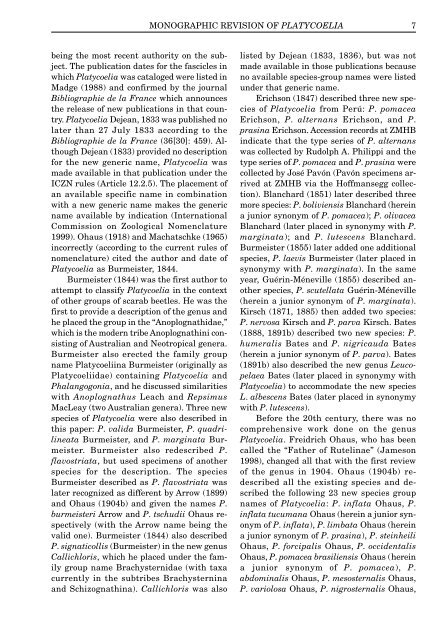Download full text (PDF 4.5 MB) - University of Nebraska State ...
Download full text (PDF 4.5 MB) - University of Nebraska State ...
Download full text (PDF 4.5 MB) - University of Nebraska State ...
You also want an ePaper? Increase the reach of your titles
YUMPU automatically turns print PDFs into web optimized ePapers that Google loves.
eing the most recent authority on the subject.<br />
The publication dates for the fascicles in<br />
which Platycoelia was cataloged were listed in<br />
Madge (1988) and confirmed by the journal<br />
Bibliographie de la France which announces<br />
the release <strong>of</strong> new publications in that country.<br />
Platycoelia Dejean, 1833 was published no<br />
later than 27 July 1833 according to the<br />
Bibliographie de la France (36[30]: 459). Although<br />
Dejean (1833) provided no description<br />
for the new generic name, Platycoelia was<br />
made available in that publication under the<br />
ICZN rules (Article 12.2.5). The placement <strong>of</strong><br />
an available specific name in combination<br />
with a new generic name makes the generic<br />
name available by indication (International<br />
Commission on Zoological Nomenclature<br />
1999). Ohaus (1918) and Machatschke (1965)<br />
incorrectly (according to the current rules <strong>of</strong><br />
nomenclature) cited the author and date <strong>of</strong><br />
Platycoelia as Burmeister, 1844.<br />
Burmeister (1844) was the first author to<br />
attempt to classify Platycoelia in the con<strong>text</strong><br />
<strong>of</strong> other groups <strong>of</strong> scarab beetles. He was the<br />
first to provide a description <strong>of</strong> the genus and<br />
he placed the group in the “Anoplognathidae,”<br />
which is the modern tribe Anoplognathini consisting<br />
<strong>of</strong> Australian and Neotropical genera.<br />
Burmeister also erected the family group<br />
name Platycoeliina Burmeister (originally as<br />
Platycoeliidae) containing Platycoelia and<br />
Phalangogonia, and he discussed similarities<br />
with Anoplognathus Leach and Repsimus<br />
MacLeay (two Australian genera). Three new<br />
species <strong>of</strong> Platycoelia were also described in<br />
this paper: P. valida Burmeister, P. quadrilineata<br />
Burmeister, and P. marginata Burmeister.<br />
Burmeister also redescribed P.<br />
flavostriata, but used specimens <strong>of</strong> another<br />
species for the description. The species<br />
Burmeister described as P. flavostriata was<br />
later recognized as different by Arrow (1899)<br />
and Ohaus (1904b) and given the names P.<br />
burmeisteri Arrow and P. tschudii Ohaus respectively<br />
(with the Arrow name being the<br />
valid one). Burmeister (1844) also described<br />
P. signaticollis (Burmeister) in the new genus<br />
Callichloris, which he placed under the family<br />
group name Brachysternidae (with taxa<br />
currently in the subtribes Brachysternina<br />
and Schizognathina). Callichloris was also<br />
MONOGRAPHIC REVISION OF PLATYCOELIA 7<br />
listed by Dejean (1833, 1836), but was not<br />
made available in those publications because<br />
no available species-group names were listed<br />
under that generic name.<br />
Erichson (1847) described three new species<br />
<strong>of</strong> Platycoelia from Perú: P. pomacea<br />
Erichson, P. alternans Erichson, and P.<br />
prasina Erichson. Accession records at ZMHB<br />
indicate that the type series <strong>of</strong> P. alternans<br />
was collected by Rudolph A. Philippi and the<br />
type series <strong>of</strong> P. pomacea and P. prasina were<br />
collected by José Pavón (Pavón specimens arrived<br />
at ZMHB via the H<strong>of</strong>fmansegg collection).<br />
Blanchard (1851) later described three<br />
more species: P. boliviensis Blanchard (herein<br />
a junior synonym <strong>of</strong> P. pomacea); P. olivacea<br />
Blanchard (later placed in synonymy with P.<br />
marginata); and P. lutescens Blanchard.<br />
Burmeister (1855) later added one additional<br />
species, P. laevis Burmeister (later placed in<br />
synonymy with P. marginata). In the same<br />
year, Guérin-Méneville (1855) described another<br />
species, P. scutellata Guérin-Méneville<br />
(herein a junior synonym <strong>of</strong> P. marginata).<br />
Kirsch (1871, 1885) then added two species:<br />
P. nervosa Kirsch and P. parva Kirsch. Bates<br />
(1888, 1891b) described two new species: P.<br />
humeralis Bates and P. nigricauda Bates<br />
(herein a junior synonym <strong>of</strong> P. parva). Bates<br />
(1891b) also described the new genus Leucopelaea<br />
Bates (later placed in synonymy with<br />
Platycoelia) to accommodate the new species<br />
L. albescens Bates (later placed in synonymy<br />
with P. lutescens).<br />
Before the 20th century, there was no<br />
comprehensive work done on the genus<br />
Platycoelia. Freidrich Ohaus, who has been<br />
called the “Father <strong>of</strong> Rutelinae” (Jameson<br />
1998), changed all that with the first review<br />
<strong>of</strong> the genus in 1904. Ohaus (1904b) redescribed<br />
all the existing species and described<br />
the following 23 new species group<br />
names <strong>of</strong> Platycoelia: P. inflata Ohaus, P.<br />
inflata tucumana Ohaus (herein a junior synonym<br />
<strong>of</strong> P. inflata), P. limbata Ohaus (herein<br />
a junior synonym <strong>of</strong> P. prasina), P. steinheili<br />
Ohaus, P. forcipalis Ohaus, P. occidentalis<br />
Ohaus, P. pomacea brasiliensis Ohaus (herein<br />
a junior synonym <strong>of</strong> P. pomacea), P.<br />
abdominalis Ohaus, P. mesosternalis Ohaus,<br />
P. variolosa Ohaus, P. nigrosternalis Ohaus,
















